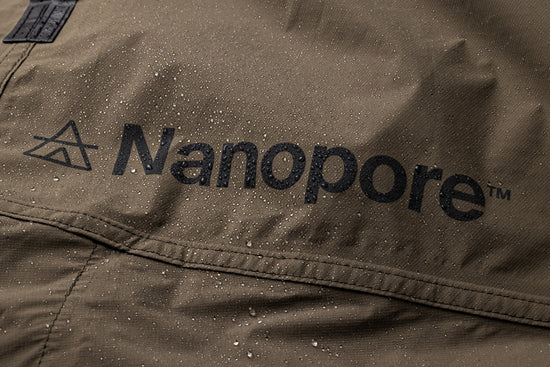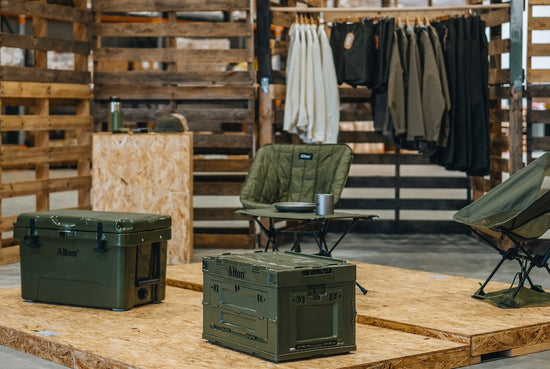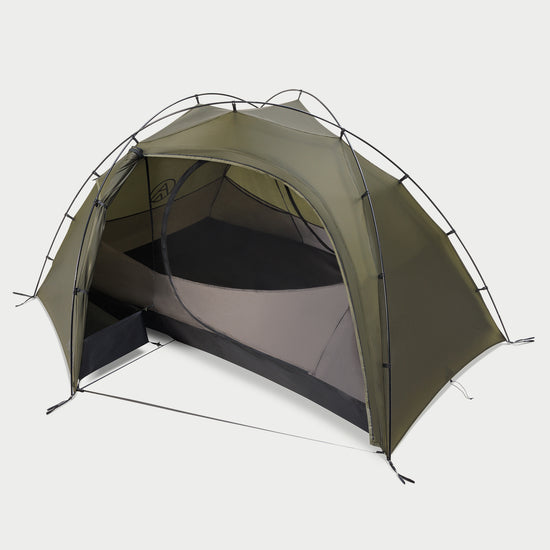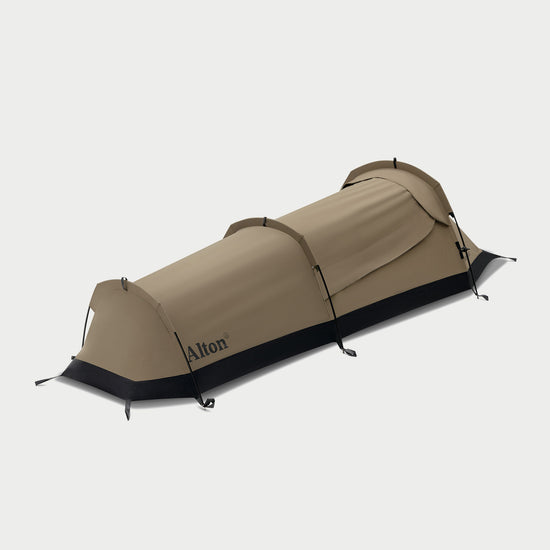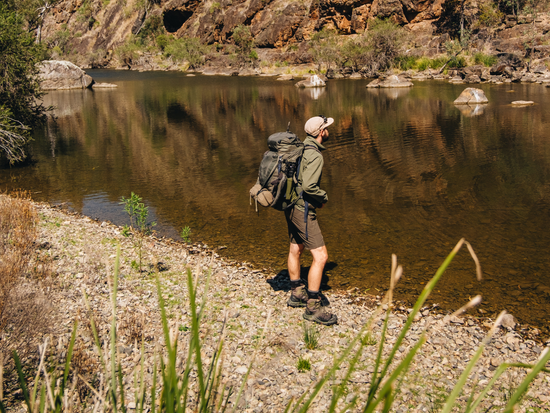If you’ve ever been tent shopping before, then you’ve probably come across the waterproof rating, or hydrostatic head rating. 1,200m, 1,500mm, 5,000mm, and so on.
But what do those numbers actually mean?
If you’re not sure, you’re not alone – most people don’t know what the hydrostatic head rating actually is, aside from the fact that the higher the number is, the more waterproof the tent fabric will be.
Because waterproof ratings seem so cut and dried (pun intended), it’s easy to fall into binary thinking: higher hydrostatic head = good, lower hydrostatic head = bad.
Bigger number = drier tent, right??
If you are a long-time reader of our blogs, you’ll probably be able to guess what we’re going to say next.
Just because a tent has a higher hydrostatic head does NOT mean it’s going to keep you drier than one with a lower hydrostatic head.
While it’s technically correct to say that the higher a fabric’s hydrostatic head rating the more waterproof it will be, this isn’t the full story when it comes to the real-world performance of a tent in the wild.
Hydrostatic head ratings are great for determining the waterproofness of a sheet of fabric, but they don’t account for all the other factors that go into making a tent waterproof, such as construction, seam sealing and placement, coating composition, fabric quality.
So in today’s blog, we’re doing a deep dive on tent waterproof ratings, including coating types, what tent waterproof ratings are used for different weather conditions and scenarios, and what you should really be looking for when choosing your next lightweight tent.
What is hydrostatic head?
When you see a tent advertised with a waterproof rating of 1,500mm, 2,000, etc., that number is referring to the hydrostatic head rating of the fabric, and it tells you how much water pressure the fabric can withstand before it starts to leak.
There are a couple of different methods used to test the hydrostatic head rating of a fabric. The most straightforward method is to clamp a section of the fabric into a vertical tube, then add water, measuring the height of the water column. The water column is then increased until the fabric starts to leak.
The other method is similar, but instead of measuring the physical height of the water column, it utilises pressure to force the water against the fabric to reproduce the equivalent pressure of a certain column of water. The pressure is increased until the fabric begins to leak.
So if you see a tent with a 1,500mm waterproof rating, that tells you that the fabric can withstand the pressure of a 1,500mm (1.5 metres) water column before it begins to leak.
It’s worth noting that the same test is used for waterproof jackets, bivvy bags, packs, and other outdoor gear made with waterproof fabric. But the ‘recommended’ hydrostatic head rating varies, depending on what the item is/how it’s used.

What most people get wrong about tent hydrostatic head ratings.
A quick online search for ‘what is a good hydrostatic head for a tent?’, will bring up a whole bunch of contradictory answers and wildly different advice on how waterproof a tent needs to be.
Some sources claim that 1,500-2,000mm is only suitable for light drizzle, and insist that 3,000-5,000mm is a must if you want to make it through a serious downpour without ending up sleeping in a puddle…
Then another source will list off the most popular (and trusted) backpacking tents, the majority of which are rated under 2,000mm. But if you need at least 3,000mm to withstand heavy rain, then why are so many excellent 3-season tents rated at just 1,200mm?!
Meanwhile, rain jackets can have +20,000mm ratings, which makes most tent numbers look absurdly low by comparison.
So what on earth is going on here? Well, there’s a few things at play:
1. Oversimplification and enshittification of online articles.
There are a LOT of articles and sources online that reduce waterproof ratings to a simple ‘higher = better’ scale. This makes for a short, skimmable article, but it skips over most of the important information… and often gets the numbers it does use wrong.
But unfortunately, the nature of the internet means that a little mistake or oversimplication can quickly spread and amplify, until it becomes so widespread that it’s taken seriously, even by professional sources.
And this ‘enshittification’ of information online has only become more extreme since the introduction of “AI” large language models.
All that to say, some of the confusion around the best waterproof ratings for tents is the result of oversimplified or incorrect information circulating online, while the more accurate information is buried deep in the search results because it’s not ‘skimmable’ or doesn’t have a click-bait-worthy headline.
2. Misunderstanding the test itself (and overlooking the real issues).
The hydrostatic head tells you how much water pressure a swatch of fabric can take in a lab. It doesn't reflect the whole tent, with its seams, coatings, and frame structure. And in reality, these factors are generally going to cause your tent to leak (or not) long before the fabric does.
When tents leak, it is almost always due to poor construction, low quality materials, or damage sustained during use. For example, even if the fabric is 3,000mm, if the seams aren’t sealed properly, they’ll become a weak point where water will find a way through.
Same goes for the floor, which is another common culprit for tent leaks. Your body weight and movement over the floor puts extra stress and pressure on the fabric, which can eventually lead the waterproof coatings to become less effective. To compensate for this, tent floors are usually made from stronger materials and have a much higher waterproof rating than the fly. Using a ground sheet is another good way to help protect the tent floor fabric and boost water-resistance.
3. Borrowing guidelines from rainwear.
Another cause of confusion is that waterproof apparel, such as rain jackets and rain pants, use hydrostatic head ratings, too… but the recommended level of waterproofing for rainwear is very different from what’s necessary for tents.
Because of this, some sources mistakenly refer to rainwear waterproof ratings when discussing tents. While this makes sense on paper (they are both hydrostatic head ratings, to be fair), a tent and a rain jacket have very different usages, so the waterproofing requirements just don’t translate.
For example, a rain jacket is exposed to a lot more abrasion, pressure, and movement. Bending at the elbows, rubbing under your backpack, creasing as you sit and stand… To manage this extra stress, a rain jacket’s fabric generally needs to be much thicker and have a significantly higher waterproof rating than that of a tent fly. Jacket fabrics also need to be highly breathable, which require breathable-waterproof membranes or advanced waterproofing technologies.
In contrast, a tent fly is held in one position under tension, so it’s subjected to less abrasion, pressure, and movement. Plus, the tent structure itself is designed to efficiently shed the water and avoid pooling.
So what is a good hydrostatic head for a tent?
From extensive research, personal experience, and real-world feedback, we’ve found that a good hydrostatic head rating for a 3-season backpacking tent falls should be in the range of 1,200-1,800mm for the outer fly and 2,000-3,000mm for the floor.
Most of the most popular 3-season backpacking tents from well-known, trusted brands fall into this range, so it’s fair to say that this range is “standard” within the industry.
Unlike some of the advice you might find online, this level of waterproofing is suitable for year round use in variable conditions, from light drizzle to heavy rain.
In our research, users consistently reported that fabric leaking was not an issue unless the tent was damaged in some other way, such as punctures, wear and tear, UV damage, or hydrolysis due to improper care/storage.
Unsealed or poorly constructed seams were also flagged as a common cause of leaks. The tiny holes made during the sewing process can act as pathways for water ingress, so all seams have to be sealed in order to be waterproof. Most tents come pre-seam sealed with heat tape, but some tents are sold unsealed with the expectation that the user will do this step at home.
The real takeaway here is that it’s not the waterproof rating that’s the issue; it’s the fabric quality, coatings, seam sealing, and overall design. These factors that will keep you dry, season after season, just as much (if not more) than the hydrostatic head rating of the fabric itself.
So does that mean you shouldn’t get a tent with a higher hydrostatic head rating? Not necessarily.

When is a higher hydrostatic head rating better?
While most users will find that a 1,200-1,800mm tent fly and 2,000-3,000mm floor will provide all the waterproofing they’ll ever need, there are a few situations where having a higher hydrostatic head rating is better:
1. Alpine Environments & Winter Weather
Alpine environments in winter are notoriously harsh. Wild storms can roll in without warning, bringing driving rain, gale-force winds, and even blizzards. Having a suitable 4-season tent with a higher hydrostatic head rating is advisable in these situations.
2. Prolonged Rain & Boggy Conditions
If you’re spending weeks or months camping in places known for having long, unrelenting rainfall, then you may be better off with a tent that has a higher hydrostatic head rating. However, the most important factor to consider for these scenarios is the specific coating composition and fabric type, as certain options are faster drying than others. If your tent has a slower drying fabric/coating and is wet for days or weeks at a time, the coating may break down due to hydrolysis and become ineffective.
3. Car Camping Tents
Weight isn’t an issue for car camping, so many tents that are designed to be pitched in a family campground or caravan park are made with much thicker fabrics with higher hydrostatic head ratings. This also makes them more durable, suitable for having furniture inside, and lots of foot traffic. The trade is obviously that car camping tents are a lot heavier and bulkier than backpacking tents.
4. Premium Ultralight Tents
If you are set on going as light as possible, you will find that ultralight tents made with laminated fabrics like Dyneema® Composite Fabric (DCF), also known as Cuban Fibre, often have hydrostatic head ratings in excess of 8,000mm, sometimes all the way up to +20,000mm. These monster ratings come from the fact that the fabric is laminated, rather than woven, resulting in a completely waterproof sheet with no pores or gaps between the threads. However, this also means that these fabrics aren’t breathable, so condensation can be an issue.
What should you look for in a tent?
Instead of obsessing over the biggest waterproof number you can find, we recommend considering the tent as a whole:
-
Fabric type. A high quality ripstop nylon fabric will be highly resilient to adverse weather conditions while still being exceptionally light. Polyester is also a good option, but it lacks a little of the natural flexibility of nylon, making it less suitable for windy conditions.
-
Denier. Fabrics with low denier (eg. 10D, 15D) fabrics are going to be much lighter than thicker weaves (eg. 40D, 60D), but they are less durable. Ripstop grids add strength without much additional weight, resulting in ultralight fabrics with significantly higher tear resistance.
-
Coating composition. The composition of the coating is just as important as the hydrostatic head rating. Silicone coatings are applied cold and soak into the fibres of the fabric, increasing the tear strength, but they make it difficult to add seam sealing. Polyurethane (PU) coatings tend to be effective in the short term, but they do need to be replenished more frequently. Dual silicone/PU coatings give you the fabric-strengthening benefits and extra water-resistance of silicone, while also allowing the seams to be sealed.
-
Construction. Even a tent with an incredibly high hydrostatic head won’t keep you dry if it isn’t made well. Look for a high-quality tent with sealed seams (or clear instructions on how to seam seal it yourself), reinforced stress point, and sturdy frame architecture that offers reliable performance in real-world conditions.
How waterproof is Alton’s Lightweight Tent?
When we made our Lightweight Tent, we opted to use 10D ripstop nylon with a 1,500mm silicone/PU coating for the fly and 15D ripstop nylon with a 2,500mm silicone/PU coating for the floor. This is right in that ‘standard’ range and is on-par with other reputable brands in the industry.
The reason we’ve been able to go so light on the fabric is because we chose a high-quality, square grid ripstop, which has a tear resistance of. The silicone/PU coating also adds a little extra strength, while giving excellent, long-lasting waterproof protection.
We also put a lot of thought into the architecture of the tent, using a three-pole geometry that is extremely stable in windy conditions and helps keep the fabric at the ideal tension to shed the rain and avoid pooling. As a part of that, we incorporated a RainGuard™ gutter and outward-opening door system that minimises dripping inside the tent so your sleeping area stays dry.
 Our final thoughts on tent waterproof ratings.
Our final thoughts on tent waterproof ratings.
When it comes to tent waterproof ratings, our advice is not to let yourself get too caught up in the numbers.
The hydrostatic head rating is one factor to consider when you’re buying a tent; not the only factor.
If you are a fairly ‘typical’ camper, meaning you are looking for a tent that can handle 3-season use in a wide variety of conditions but don’t regularly participate in extreme expeditions like winter/snow camping or do extended trips in constant rain, then a hydrostatic head rating of 1,200-1,800mm for the fly and 2,000mm-3,000mm for the floor will get the job done.
Going for higher hydrostatic head ratings than this probably won’t make a noticeable difference for typical use scenarios like backpacking, bike touring, and weekend camping trips.
However, depending on the fabric/coating type used, having a higher hydrostatic head rating might add weight and bulk, as the fabric needs to be thicker, with more layers of coating, to achieve that extra level of waterproofing. This also decreases the breathability of the fabric, so you may find that condensation is more of an issue.
If you go for the ultralight tent options (which often have hydrostatic head ratings over 10,000mm), you can get extreme waterproof ratings, but you’ll definitely pay for it, because these tents come at a premium. In the field, the difference in waterproof performance between a 1,500mm ripstop nylon tent and a 15,000mm DFC tent is not as dramatic as you might expect; the main benefit of these fabrics is how light they are.
At the end of the day, the best tent for you isn't necessarily going to be the one with the highest waterproof rating. So next time you’re checking out the spec sheet, don’t just ask yourself, “What’s the hydrostatic head number?”... Ask, “Does this tent have the right fabric, construction, features, and level of waterproof protection for my specific needs?”
Do that, and you’ll end up with a tent that actually feels like home in the wild – and stays dry, too.



